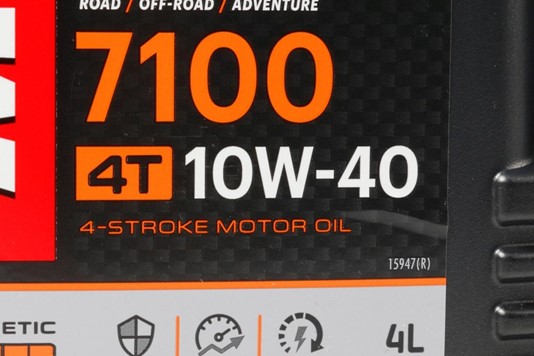Motorcycle Engine Oil: The Need-To-Knows

Motorcycle engine oil: The Need-To-Knows

The oil is the lifeblood of your motorcycle engine and is crucial to both its smooth running and its longevity.
There are three main types of engine oil, namely mineral, semi-synthetic, and fully synthetic. Each type is available in many different grades, such as 10W-40 and 20W-50, and there are industry standards, such as API and JASO, that the oils must be manufactured to. Manufacturers put all the relevant information on the type, grade, and standard on the oil container label.
It is essential that you use the correct engine oil as specified by the motorbike manufacturer, even if it seems expensive. Basing your decision on which oil to use by price alone is risky and can lead to serious engine damage and costly repairs.
Oil wears out both with use and over time, even if the bike is not being used much, and so it must be changed at each service interval specified by the manufacturer. Motorcycle manufacturers specify the type and grade, and often the brand, of oil you should use, and the details will be in your handbook or can be obtained from a dealer. It is also essential that you check your engine oil level frequently between service intervals, even when the bike is new and the mileage is low.

Mineral, semi-synthetic or fully-synthetic – what is the difference?
Most engine oils, including many fully synthetic ones, are derived from the crude oil that comes out of the ground, and it is the way that the properties and molecular structure of the crude oil is then modified, refined and synthesised that determines whether it becomes classified as a mineral, semi-synthetic or fully synthetic product.
Mineral oil is the most basic of the three types and is the cheapest but is only suitable for use in older low-performance engines.
Fully synthetic oil is the most sophisticated and durable oil and is a requirement for many modern engines, particularly high-performance ones. Modern engine technology, manufacturing tolerances and performance would not be possible without fully synthetic oil. It is the most expensive of the three types and is worth it if your engine demands it.
Semi-synthetic oil sits between mineral and fully synthetic in all aspects, including cost, and is sufficient for many engines where high performance is not their defining character.
How are motorcycle engine oils graded and what does the grading mean?

Motorcycle engine oils for four-stroke engines are graded according to their viscosity, or thickness. The viscosity determines not only how well it flows through the passages around the engine and into the tiny gaps between fixed and moving components, but also how well it performs as an anti-wear lubricant. The thicker the oil the less well it flows but the better it lubricates and protects, the thinner the oil, the better it flows but the less well it lubricates and protects. However, the viscosity of oil changes with temperature, becoming thinner as it becomes hotter.
Ideally, you need an oil that offers the required flow and lubrication properties at all temperatures, thin enough to flow at low temperatures and thick enough to protect and lubricate satisfactorily at high temperatures. This is where modern multi-grade oils that contain viscosity index improvers, such as an SAE 10W-30, cope significantly better than old single grade oils, such as an SAE 30.
What do the letters and numbers mean?
SAE stands for the Society of Automotive Engineers, which established the numerical coding system for grading engine oils according to their viscosity characteristics. The number(s) relate to those viscosity characteristics. Multi-grade oils have two numbers, the first of which relates to the viscosity of the oil at low temperatures and is followed by the letter W (for Winter) – the lower the number, the thinner the oil and the better the oil’s cold temperature/start-up performance, when most engine wear occurs. The second number represents the viscosity at high temperatures – the higher the number, the thicker the oil and the better the oil’s performance at the engine’s normal operating temperature. Confusingly the numbers bear no relation to either ambient temperature or the temperature of the engine, but the chart below gives a guide as to which oil is best suited to which environment, and shows that for most environments a 10W-40 will suffice, unless you live in northern Siberia or the middle of the Sahara. However it must be stressed that a motorcycle manufacturer may specify a grade of oil for a particular engine that does not conform with the chart, and they do so with good reason because of the characteristics of that engine, and that specification should be used.

And in case you were wondering, the 4T that is marked on the oil container means it is oil for a four-stroke engine.
Oils for two-stroke engines, in which the oil is mixed and combusted with the petrol, are marked 2T and are not given a viscosity grade.
How are motorcycle engine oils standardised in manufacture?

There are three main ways that engine oils are standardised, in Europe by the ACEA (Association des Constructeurs European d’Automobiles), in America by the API (American Petroleum Institute), and in Japan by the JASO (Japanese Automotive Standards Organisation). Motorcycle engine oils tend to use the API and JASO standards and in particular, the globally recognised JASO T903 M standard that applies specifically to motorcycle oils, whereas API standards apply to both motorcycle and car oils. The standards appear on the product label in the form API- followed by two letters, such as API-SJ, API-SL or API-SM, and JASO T903- followed by MA, MA1, MA2, or MB for four-stroke engines, and FA, FB, FC, or FD for two-stroke engines.
API standards
SA to SE – from 1979 to 1996, now obsolete
SF/SG/SH – from 1979 to 1996, now mostly obsolete
SJ/SL/SM/SN – from 1996 to current
JASO standards
JASO T903 MA – oils for 4-stroke motorcycle engines with one lubrication system for the engine, clutch and transmission, i.e. those with a wet clutch that is lubricated by the oil, and the transmission incorporated in the crankcases. These oils contain no friction modifiers and deliver the needed friction performance to prevent the clutch from slipping.
JASO T903 MB – oils for 4-stroke motorcycle engines with an automatic belt transmission (known as constantly variable transmission or CVT) as used on most scooters. These oils contain friction modifiers to reduce the amount of friction in a running engine and so deliver improved fuel economy.
JASO T903 F – oils for 2-stroke motorcycle engines.
JASO T903 MA standards
MA – standard specification for engines with one lubrication system for the engine, clutch and transmission.
MA1 – lower standard specification for engines with a separate lubrication system for the gearbox.
MA2 - higher specification for engines with one lubrication system for the engine, clutch and transmission and with a catalytic converter in the exhaust system.
JASO T903 F standards
These standards are based on lubrication, detergency, initial torque, exhaust smoke and carbon build-up capabilities.
FA – lowest standard, declared obsolete in 2005.
FB – slightly higher standard than FA in all capabilities.
FC – same standard as FB for lubrication and initial torque, higher standard for detergency, and smoke/carbon build-up.
FD – same standard as FC for lubrication, initial torque and smoke/carbon build-up, higher standard for detergency.
What oil should I use?

The golden rule is to use the type and grade of motorcycle engine oil that the manufacturer of your motorbike recommends, and in some cases where particular metals may be used in certain components, you must also use the particular brand that is specified as it will have been developed to be compatible with those materials. However, in cases of emergency and for short-term use only, the motorcycle engine oil that is nearest to the recommended type and grade is better than too little or none of the recommended one.
For example, a semi-synthetic oil can be used instead of a fully synthetic one, but you should not use a mineral oil.
If you cannot match the grade of oil exactly to that specified, you can use an oil with a wider viscosity range, such as a 5W-40 instead of a 10W-30, as the required range is covered, but you should not use a 10W-40 instead of a 20W-50, as even though the lower range is covered the upper range is not.
If the manufacturer of your bike recommends API-SM and JASO-MA2 you should not use an oil graded only to API-SF or JASO-MA standard, as the later alphabetical or higher numerical denomination indicates a higher and more recent standard. However, if an API-SF or JASO-MA is recommended you can use an API-SG or higher or a JASO-MA2 oil. Most oils available for purchase now will be of the higher and later standards as lower and older standards become obsolete.
What oil shouldn’t I use?

DO NOT use a single grade oil in an engine that needs multi-grade.
DO NOT use any oil classified for car engines, even if the type and grade is correct. Oil is not just oil, and motorcycle oils are different for a reason.
DO NOT use a JASO T903 MB oil where an MA oil is specified. An MA oil can be used if necessary where an MB oil is specified.
DO NOT use an API-C or JASO-D standard oil as these are for diesel engines. Unless of course you have a bike with a diesel engine…..
